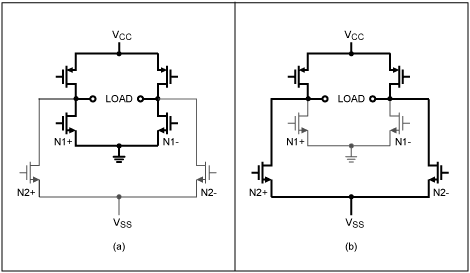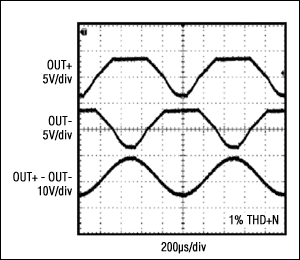Abstract: Maxim uses innovative G-type technology and charge pump-based architecture to introduce an enhanced amplifier. These amplifier designs are ideal for portable applications that require high voltage output without sacrificing efficiency or PCB space. This application note explains the advantages of using charge pumps and Class G technology in speaker power drive circuits. The MAX9730 and MAX9788 speaker amplifiers are used as design examples.
Overview A common problem in portable audio applications is the limited supply voltage of speaker amplifiers. These audio systems are usually powered by lithium ion (Li +) batteries and have an output rating of 3.7V. Although the 3.7V power supply is sufficient to ensure the normal operation of most components of the system, in order to provide satisfactory sound pressure, the speaker amplifier requires a higher supply voltage. Therefore, the power stage of most speaker amplifiers uses a bridge load configuration to produce twice the supply voltage on the speaker.
In most cases, doubling the speaker supply voltage is sufficient to meet the requirements, but some applications require greater output power. For example: piezoelectric speakers (requires higher voltage drive) or systems that require higher sound pressure (such as GPS devices). In response to the needs of these audio applications, the only solution is to increase the power supply voltage, usually requiring a separate DC-DC boost converter, thereby increasing the cost and complexity of the system.
Class G amplifiers MAX9730 and MAX9788 use a charge pump to boost the power supply voltage to solve the power supply voltage problem. The MAX9730 is suitable for traditional dynamic speakers, while the MAX9788 is suitable for ceramic speakers.
Compared with the standard 5V amplifier, the innovative charge pump uses a charge pump to double the output level of the MAX9730 and MAX9788. The charge pump is fully integrated inside the amplifier, requiring only two external capacitors, and a 0603 miniature surface mount capacitor can be used. The integrated charge pump generates a negative voltage with an amplitude equal to the power supply voltage, which doubles the power supply voltage and ultimately doubles the output swing.
Unlike the DC-DC boost converter, the charge pump has a large output impedance, which will cause the negative power supply to drop when loaded. The design of the MAX9730 and MAX9788 can ensure that the output impedance of the charge pump is low enough to provide sufficient output power. When the traditional amplifier is powered by 3.7V, it can provide 700mW drive to an 8Ω load, and the MAX9730 can provide 1.3W output drive under the same conditions.
Unique Class G technology Because the MAX9730 and MAX9788 use 10V amplifiers to replace the common 5V amplifiers in handheld devices, maintaining high efficiency becomes the key to extending battery life. Although Class D technology is highly efficient and commonly used in handheld devices, it does not meet the driving requirements of ceramic speakers. The design challenge is very clear-ceramic speakers require other drive technologies. Class G amplifier, an unknown amplifier technology, has been introduced to the market due to its perfect adaptability.
The working principle of Class G amplifiers is similar to Class AB amplifiers, except for multiple supply voltages rather than a fixed voltage. As the input signal amplitude changes, the G-type architecture can automatically select the appropriate power supply, thereby minimizing the voltage drop of the output transistor and greatly improving efficiency. Class G amplifiers are usually powered by two positive power supplies. Higher power supplies are used to output higher levels, and lower power supplies are used to output lower levels.
Class G amplifiers MAX9730 and MAX9788 use Class G technology in a unique way. They generate negative pressure from the charge pump instead of high and low positive power supplies. When the amplifier produces a smaller output signal, the amplifier is powered by the battery voltage and ground. In this mode, the device works in a similar way to the common 5V class AB amplifier (Figure 1a). When the output signal exceeds the power supply voltage, the amplifier selects the battery voltage and the negative charge pump output power supply (Figure 1b). As a result, the amplifier can output signals much higher than traditional amplifiers.

Figures 1a and 1b. MAX9788 Class G output stage operating at lower voltage (a) and higher voltage (b).
The MAX9730 and MAX9788 ensure that switching between the two power supplies does not produce audio noise. When the output signal reaches the limit allowed by VCC and GND power supply, the negative power supply is automatically connected to the output stage. In this way, the output signal will not be clipped on the negative swing side, but it will still clamp its positive swing. To correct this, the amplifier adds an additional correction signal to the negative polarity output, as shown in Figure 2. When observing the positive and negative outputs separately, the positive half-cycle waveform is significantly truncated, while the negative half-cycle has significant distortion. Although these signals are severely distorted, they are strictly controlled to take full advantage of the architecture. The actual output signal applied to the load is not distorted.

Figure 2. Class G output waveform generated by MAX9788.
Conclusion Combining Class G technology with a negative pressure charge pump, the MAX9730 and MAX9788 can provide an effective solution to the common problems faced by audio design. Most amplifiers that provide boost internally require large inductors, and the MAX9730 and MAX9788 only need to use two small capacitors, which helps save PCB space and cost. The MAX9730 and MAX9788 use an efficient Class G structure to reduce current consumption and improve existing designs.
In most cases, doubling the speaker supply voltage is sufficient to meet the requirements, but some applications require greater output power. For example: piezoelectric speakers (requires higher voltage drive) or systems that require higher sound pressure (such as GPS devices). In response to the needs of these audio applications, the only solution is to increase the power supply voltage, usually requiring a separate DC-DC boost converter, thereby increasing the cost and complexity of the system.
Class G amplifiers MAX9730 and MAX9788 use a charge pump to boost the power supply voltage to solve the power supply voltage problem. The MAX9730 is suitable for traditional dynamic speakers, while the MAX9788 is suitable for ceramic speakers.
Compared with the standard 5V amplifier, the innovative charge pump uses a charge pump to double the output level of the MAX9730 and MAX9788. The charge pump is fully integrated inside the amplifier, requiring only two external capacitors, and a 0603 miniature surface mount capacitor can be used. The integrated charge pump generates a negative voltage with an amplitude equal to the power supply voltage, which doubles the power supply voltage and ultimately doubles the output swing.
Unlike the DC-DC boost converter, the charge pump has a large output impedance, which will cause the negative power supply to drop when loaded. The design of the MAX9730 and MAX9788 can ensure that the output impedance of the charge pump is low enough to provide sufficient output power. When the traditional amplifier is powered by 3.7V, it can provide 700mW drive to an 8Ω load, and the MAX9730 can provide 1.3W output drive under the same conditions.
Unique Class G technology Because the MAX9730 and MAX9788 use 10V amplifiers to replace the common 5V amplifiers in handheld devices, maintaining high efficiency becomes the key to extending battery life. Although Class D technology is highly efficient and commonly used in handheld devices, it does not meet the driving requirements of ceramic speakers. The design challenge is very clear-ceramic speakers require other drive technologies. Class G amplifier, an unknown amplifier technology, has been introduced to the market due to its perfect adaptability.
The working principle of Class G amplifiers is similar to Class AB amplifiers, except for multiple supply voltages rather than a fixed voltage. As the input signal amplitude changes, the G-type architecture can automatically select the appropriate power supply, thereby minimizing the voltage drop of the output transistor and greatly improving efficiency. Class G amplifiers are usually powered by two positive power supplies. Higher power supplies are used to output higher levels, and lower power supplies are used to output lower levels.
Class G amplifiers MAX9730 and MAX9788 use Class G technology in a unique way. They generate negative pressure from the charge pump instead of high and low positive power supplies. When the amplifier produces a smaller output signal, the amplifier is powered by the battery voltage and ground. In this mode, the device works in a similar way to the common 5V class AB amplifier (Figure 1a). When the output signal exceeds the power supply voltage, the amplifier selects the battery voltage and the negative charge pump output power supply (Figure 1b). As a result, the amplifier can output signals much higher than traditional amplifiers.

Figures 1a and 1b. MAX9788 Class G output stage operating at lower voltage (a) and higher voltage (b).
The MAX9730 and MAX9788 ensure that switching between the two power supplies does not produce audio noise. When the output signal reaches the limit allowed by VCC and GND power supply, the negative power supply is automatically connected to the output stage. In this way, the output signal will not be clipped on the negative swing side, but it will still clamp its positive swing. To correct this, the amplifier adds an additional correction signal to the negative polarity output, as shown in Figure 2. When observing the positive and negative outputs separately, the positive half-cycle waveform is significantly truncated, while the negative half-cycle has significant distortion. Although these signals are severely distorted, they are strictly controlled to take full advantage of the architecture. The actual output signal applied to the load is not distorted.

Figure 2. Class G output waveform generated by MAX9788.
Conclusion Combining Class G technology with a negative pressure charge pump, the MAX9730 and MAX9788 can provide an effective solution to the common problems faced by audio design. Most amplifiers that provide boost internally require large inductors, and the MAX9730 and MAX9788 only need to use two small capacitors, which helps save PCB space and cost. The MAX9730 and MAX9788 use an efficient Class G structure to reduce current consumption and improve existing designs.
Smart Heater means a heater with Wifi control by Phone.
Smart heaters inluding Fan Heater Wifi, Glass Panel Heater Wi-fi, Oil-filled heater Tuya, Wifi wall Silicate Panel Heater, Glass convection heater App.
Featuring a compact design, the Smart Heaters can be controlled from the heaters or connecting the smart Wifi Heater using Tuya's free mobile app to adjust settings from your hand. Monitors and manages the temperature in your home or office, set timers, or simply select the time of day you`d like to activate your Wifi heater.
Welcome to OEM smart heaters, we use Tuya app.
thanks
Smart Heater
Smart Water Heater,Life Smart Heater,Wifi Heater,Smart Space Heater
Fenry manufacturing Co., Ltd , https://www.cnfenry.com